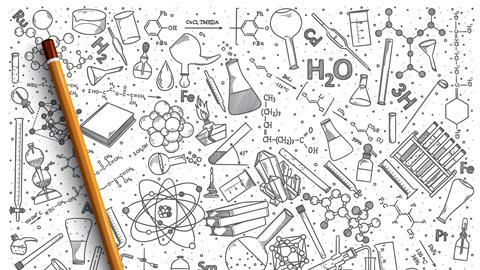Researchers found that writing down facts while muttering aloud is not the best way to build a solid knowledge base in science
Researchers from the Netherlands have found drawing is a better strategy than writing for memorising scientific statements. Also, although other research suggests muttering while studying text helps recall it, these researchers found the opposite in their recent study.
Science teachers need to be aware of methods that help their students develop long lasting stores of information. A crucial aim is to help students develop a solid knowledge base and the ability to recall this knowledge swiftly and accurately. This enables new knowledge and understanding. To offer a parallel, it’s difficult to succeed in maths if you don’t know your times tables. It is also essential that fundamental information is properly engrained in students’ memories at the outset, because the learning arcs for science concepts cover long periods.
A wealth of literature suggests humans process information via two separate sensory systems: visual and auditory. These can be used simultaneously. However, both are limited by the working memory capacity of the individual. More working memory capacity can be freed by memorisation. It’s been suggested information encoded as pictures or drawings assists the learning process.
Frits Pals and his team at the University of Groningen aimed to find out which memorisation tactics are best for science students. They randomly assigned 157 students, between the ages of 13 and 15, to one of four test conditions: writing in silence; writing while muttering; drawing in silence; or drawing while muttering.
Drawers less distracted
All students were instructed to memorise the same nine scientific statements, such as ‘You heat sugar in a test tube’ and ‘You use vinegar to remove the calcium deposits in the coffee maker’, but using only the test condition they had been assigned. The researchers read each statement aloud twice to students, and displayed each for 45 seconds.
After five minutes, they asked students to write down as many of the statements as they could recall. Students were asked to do this again after one week, and then again three weeks later.
Unsurprisingly, the number of correctly recalled statements decreased for all test conditions over the three-week period. However, the rate of decline differed substantially between the groups, particularly between those students who were writing and those drawing.
Students who drew only forgot about half of an initially correctly recalled statement on average; whereas, students who wrote forgot around one and half after three weeks. In other words, long-term memorisation is best achieved through drawing.
Students in the writing group instructed to mutter recalled the fewest number of correct statements on all three occasions. Significantly, there was very little difference in recall ability between the two drawing groups. This might suggest that memorisation by drawing is more robust to distractions.
Teaching Tips
- Space opportunities to memorise key facts, statements and underlying knowledge throughout learning sequences.
- Students carrying out a memorisation task should probably do so quietly (and you may prefer this from a behaviour management point of view).
- Rather than repetitive rewriting of the key phrases, encourage pupils to draw pictorial representations.
- This idea of encoding information in a drawing is very similar to the ‘dual coding’ strategy. Find out more about dual coding: www.learningscientists.org/dual-coding.
- If you’ve got a class that is prone to low-level chit chat, then a drawing task is more likely to be effective.
Teaching Tips
- Space opportunities to memorise key facts, statements and underlying knowledge throughout learning sequences.
- Students carrying out a memorisation task should probably do so quietly (and you may prefer this from a behaviour management point of view).
- Rather than repetitive rewriting of the key phrases, encourage pupils to draw pictorial representations.
- This idea of encoding information in a drawing is very similar to the ‘dual coding’ strategy.
- If you’ve got a class that is prone to low-level chit chat, then a drawing task is more likely to be effective.
References
F F B Pals, et al., Int. J. Sci. Educ., 2018, 40, 227 (DOI: 10.1080/09500693.2017.1407885)















No comments yet